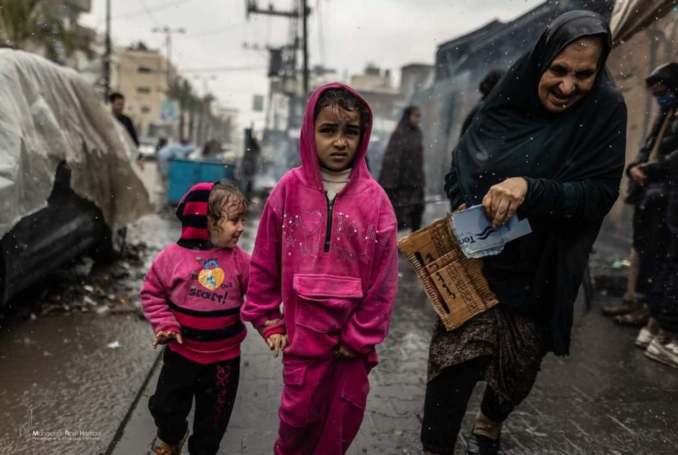
By Nurah Tape – The Palestine Chronicle 
The United Nations Conference On Trade And Development (UNCTAD) issued a comprehensive report on Wednesday regarding the disastrous future awaiting Gaza after the war. These are its main points.
A United Nations report has assessed that if Israel’s current assault on the Gaza Strip was to immediately end, it would take decades and substantial foreign aid to rebuild the socioeconomic conditions in the besieged enclave to pre-conflict levels.
The assessment came in a report by the United Nations Conference On Trade And Development (UNCTAD) on Wednesday that quantifies GDP loss, recovery timelines, and enduring effects on poverty and household expenditure.
“It paints a daunting picture of the development challenges ahead,” UNCTAD said in a statement.
Utilizing innovative satellite imagery and official data, UNCTAD currently estimates that the Gazan economy had already contracted by 4.5 percent in the first three quarters of 2023.
However, the military operation has greatly accelerated the decline and precipitated a 24 percent GDP contraction and a 26.1 percent drop in GDP per capita for the entire year.
The UN agency said, “If the current military operation were to end immediately with reconstruction starting right away and the 2007-2022 growth trend persists with an average growth rate of 0.4 percent, it would take Gaza until 2092 just to restore the GDP levels of 2022 with GDP per capita and socioeconomic conditions continuously declining.”
However, the statement added, even with the most optimistic scenario that GDP could grow at 10 percent annually it would still take Gaza’s GDP per capita until 2035 to pre-blockade level of 2006.
‘Access to Clean Water in Gaza is a Matter of Life and Death’ – UNRWA
Financial Commitment Required
The recovery of Gaza’s economy from the current military operation will demand a financial commitment, several times the $3.9 billion that resulted from the 2014 military operation in Gaza and will involve a concerted international effort to restore pre-conflict socioeconomic conditions, according to the report.
Socioeconomic conditions in Gaza were dire in 2022 and the first half of 2023, with over two million Gazans confined to one of the most densely populated spaces in the world suffering inadequate access to clean water, sporadic electricity provision and without a proper sewage system.
“Two-thirds of the population lived in poverty and 45 percent of the workforce were unemployed before the beginning of the latest military operation,” UNCTAD said.
The ongoing military operation has displaced 85 percent of Gaza’s population, halting economic activities and further worsening poverty and unemployment.
As of December 2023, unemployment had surged to 79.3 percent. Meanwhile, 37,379 buildings—equivalent to 18% of the Gaza strip’s total structures—have been damaged or destroyed by the military operation.
The Gaza Strip, half of whose population are children, is now rendered almost uninhabitable with people lacking adequate sources of income, access to water, sanitation, health or education.
How Long Will It Take for Gaza to Recover? – UN Trade Body Has the Answer
Ending the Blockade
The Report highlights the pressing need to break the cycle of economic destruction that has rendered 80% of the population dependent on international aid and warns that a return to the pre-conflict status quo is not an option.
“The possibility and speed of recovery in Gaza will depend on ending military operation, donors’ engagement and subsequent growth performance,” UNCTAD said.
UNCTAD’s assessment, however, warns that a new phase of economic rehabilitation cannot simply take as its goal a return to the pre-October 2023 status quo.
“The vicious circle of destruction and partial reconstruction needs to be broken,” it said.
Gaza’s economic constraints, rooted in 56 years of occupation and a 17-year blockade, necessitate thorough understanding and realistic strategies to unlock its growth potential through measures, UNCTAD stressed.
These measures include “restoring the Gaza International Airport (today inoperable), building a seaport and enabling the Palestinian government to develop the natural gas fields discovered in the 1990s in the Mediterranean Sea off the shore of Gaza to help finance the reconstruction of infrastructure.”
Next Hours are Vital – Latest Updates on Gaza Ceasefire Talks
Budget to Support Government
The report emphasizes the importance of providing immediate and robust budget support to the Palestinian government.
“Such support would help prevent a wider collapse by sustaining governance, delivering essential public services, and maintaining aggregate demand through salary payments and clearance of arrears to the private sector,” the UN agency said.
Foreign aid declined from a total of $2 billion, or 27 per cent of GDP, in 2008, to $550 million, or less than 3 percent of GDP, in 2022.
UNCTAD warned that resolution of Gaza’s crises “requires ending the military operation and the lifting of the blockade, as a pivotal step toward realizing a two-state solution along 1967 borders, in line with international law and relevant United Nations resolutions.”
The UN agency urged donors and the international community “to recognize that the constraints on the Palestinian economy, specifically in Gaza, extend beyond the recent confrontation.”
(The Palestine Chronicle)

– Nurah Tape is a South Africa-based journalist. She is an editor with The Palestine Chronicle.







